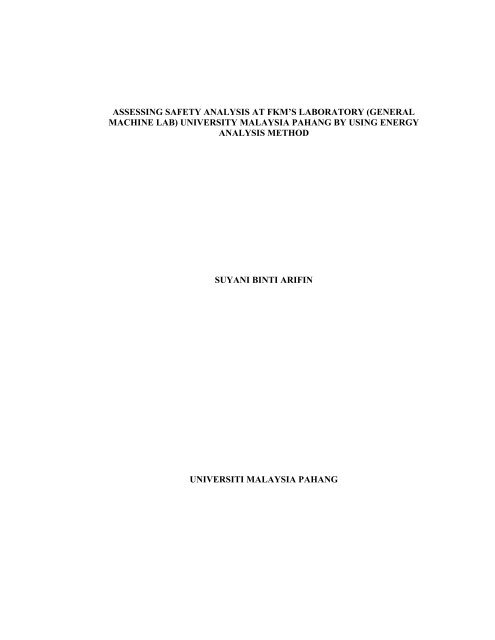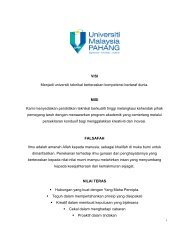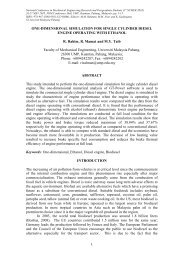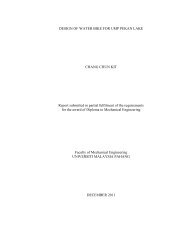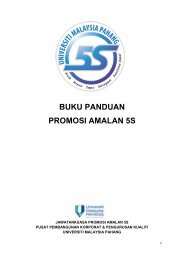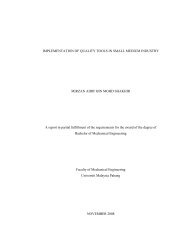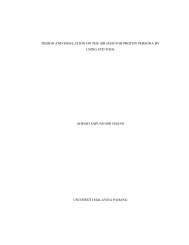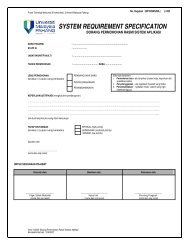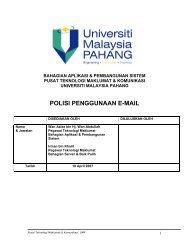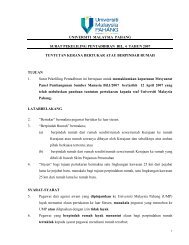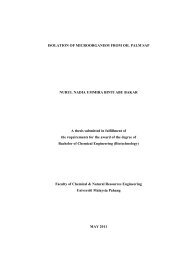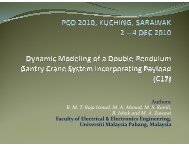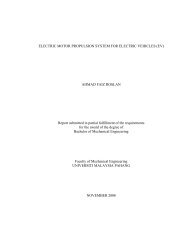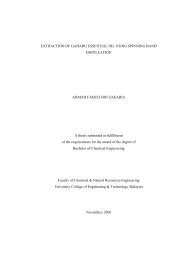assessing safety analysis at fkm's laboratory - Universiti Malaysia ...
assessing safety analysis at fkm's laboratory - Universiti Malaysia ...
assessing safety analysis at fkm's laboratory - Universiti Malaysia ...
You also want an ePaper? Increase the reach of your titles
YUMPU automatically turns print PDFs into web optimized ePapers that Google loves.
CHAPTER 4POLICY AND LEGAL OPTIONS AND RECOMMENDATIONS …………………………………............………… 49Measures to Promote Transparency and Accountability …………………………………………………............... 49Constitutional Reforms ………………………………………………………………………………………………………………........ 49Joining the Extractive Industry Transparency Initi<strong>at</strong>ive (EITI) ……………………………………………………....... 50Role of Parliament ……………………………………………………………………………………………………………………............. 51Voluntary Reporting by Mining Companies ……………………………………………………………………………........... 52Mining Rights and Contracts …………………………………………………………………………………………....................... 52Awarding Mining Rights to Investors …………………………………………………………………………………………........ 52Review of Existing Mining Contracts …………………………………………………………………………………………......... 52Mining Contract Negoti<strong>at</strong>ion ……………………………………………………………………………………………………......... 53Revenue Gener<strong>at</strong>ion and Community Particip<strong>at</strong>ion in Mining ……………………………………………......... 54Mining Tax<strong>at</strong>ion Regime …………………………………………………………………………………………………….................... 54Cre<strong>at</strong>ion of Inter-Gener<strong>at</strong>ional Fund …………………………………………………………………………………………....... 55Community Particip<strong>at</strong>ion in Mining and Indigenis<strong>at</strong>ion ………………………………………………………………. 55Corpor<strong>at</strong>e Social Responsibility …………………………………………………………………………………………………....... 57Position of Reloc<strong>at</strong>ed/Displaced Communities ……………………………………………………………………............. 58Legal Reforms in the Mining Sector ………………………………………………………………………………....................... 58Proposed Diamond Law ……………………………………………………………………………………………………….................. 58Amending the Mines and Minerals Act ………………………………………………………………………………………...... 59etablihment of an Environmental Court ……………………………………………………………………………………........ 60Compliance with Intern<strong>at</strong>ional Standards ………………………………………………………………………................... 60Compliance with the Kimberly Process Certific<strong>at</strong>ion Scheme Requirements ………………………………. 60Working with Civil Society and Communities …………………………………………………………………................... 61REFERENCES ……………………………………………………………………………………………………………...............................… 62
“To my beloved mother and f<strong>at</strong>her. You are everything to me and always be therewhenever I need you”
ABSTRAKAnalisis keselam<strong>at</strong>an dengan menggunakan cara menganalisis tenaga telahdigunakan ke <strong>at</strong>as makmal Fakulti Kejuruteraan Mekanikal (FKM) <strong>Universiti</strong><strong>Malaysia</strong> Pahang. Analisis ini di aplikasikan dalam makmal FKM 3A yangmerangkumi mesin umum seperti mesin kisar (milling) dan mesin larikkonvensional. Tujuan analisis ini adalah untuk mengenalpasti dan menilai bahayaberlaku di makmal FKM menggunakan kaedah analisis tenaga. Pendek<strong>at</strong>an untukkajian ini berdasarkan konsep tenaga dan kaedah langsung yang bernama AnalisisTenaga. Cara ini adalah sesuai untuk mendap<strong>at</strong> s<strong>at</strong>u gambaran keseluruhan dengancep<strong>at</strong> tentang bahaya yang sedia <strong>at</strong>au telah wujud dalam bentuk tenaga. Proses yangter<strong>at</strong>ur dan sistem<strong>at</strong>ik dilakukan untuk menunjukkan bagaimana analisis ini bolehdijalankan. Analisis tenaga merupakan kaedah yang efisen dalam mengenal pastibahaya yang wujud di makmal FKM 3A. Bahaya telah dikenalpasti melalui kajiselidik, permerh<strong>at</strong>iah dan temu ramah yang telah dilakukan. Dengan menganalisissemua bahaya yang telah dikenalpasti, pelbagai langkah-langkah keselam<strong>at</strong>andicadangkan. Cadangan ini juga adalah untuk meningk<strong>at</strong>kan keselam<strong>at</strong>an di temp<strong>at</strong>kerja.
TABLE OF CONTENTSUPERVISOR’S DECLARATIONSTUDENT’S DECLARATIONACKNOWLEDGEMENTSABSTRACTABSTRAKTABLE OF CONTENTSLIST OF TABLESLIST OF FIGURESPageiiiiiivvviviixixiiCHAPTER 1INTRODUCTION1.1 Background of Study 11.3 Problem St<strong>at</strong>ement 21.3 The Objectives of the Research 21.4 Scope of Study 2CHAPTER 2LITERATURE REVIEW2.1 General 32.1.1 Definition of <strong>safety</strong> <strong>analysis</strong> 42.1.2 Definition of risk <strong>analysis</strong> 42.1.3 The system<strong>at</strong>ic approach 52.2 Classific<strong>at</strong>ion of Hazard 52.2.1 Respir<strong>at</strong>ory Hazard 52.2.2 Corrosive Hazard 62.2.3 Energy Hazard 62.2.4 Engulfment (contents) Hazard 62.2.5 Fire and Explosive Hazard 7
2.2.6 Mechanical Equipment Hazard 72.2.7 Fall hazard 72.2.8 Environmental Condition Hazard 72.3 Selection Method 82.4 Energy Analysis 92.4.1 Principles 92.5 Example of Applic<strong>at</strong>ion Analysis 12CHAPTER 3METHODOLOGY3.1 Introduction 133.2 Flow Chart3.2.1 Final Year Project 1 163.2.2 Final Year Project 2 173.3 Flow Chart Explan<strong>at</strong>ion 183.4 D<strong>at</strong>a Collection 193.4.1 Survey (questionnaire) 193.4.2 Observ<strong>at</strong>ion 193.4.3 Interview 203.5 Analysis Procedure3.5.1 Prepar<strong>at</strong>ion 203.5.2 Structure 203.5.2.1 Conventional L<strong>at</strong>he Machine 213.5.2.2 Milling Machine 223.5.3 Identify Energies 233.5.4 Assess Risk 243.5.5 Propose Safety Measure 24CHAPTER 4RESULTS AND DISCUSSION4.1 Introduction 254.2 Survey Analysis 254.2.1 Question 1 264.2.2 Question 2 274.2.3 Question 3 284.2.4 Question 4 294.2.5 Question 5 304.2.6 Question 6 314.2.7 Question 7 324.2.8 Question 8 334.2.9 Question 9 34
4.2.10 Question 10 354.2.11 Question 11 364.3 Observ<strong>at</strong>ion 374.3.1 Conventional l<strong>at</strong>he machine (former) and Conventional 38l<strong>at</strong>he machine (new)4.3.1.1 Potential Energy 394.3.1.2 Kinetic Energy 394.3.1.3 Rot<strong>at</strong>ional Movement 404.3.1.4 Hot and Cold 404.3.1.5 Miscellaneous 404.3.2 Milling Machine 414.3.2.1 Potential Energy 414.3.2.2 Kinetic Energy 424.3.2.3 Rot<strong>at</strong>ional Movement 424.3.2.4 Hot and Cold 434.3.2.5 Miscellaneous 434.3.2 Observ<strong>at</strong>ion Picture 434.4 Interview 464.5 Analysis Procedure 474.5.1 Volume of Conventional L<strong>at</strong>he Machine 474.5.2 Volume of Milling Machine 494.6 Propose improvement on <strong>safety</strong> 514.6.1 Employer <strong>safety</strong> oblig<strong>at</strong>ion (FKM labor<strong>at</strong>ory51management)4.6.2 Employee <strong>safety</strong> oblig<strong>at</strong>ions (Students) 52CHAPTER 5CONCLUSION AND RECOMMENDATIONS5.1 Conclusion 545.2 Recommend<strong>at</strong>ion 55REFERENCES 56APPENDICES 58A Checklist of questions to survey for machine guarding problems 58from Reference OSHA Standards 1910.211-2.19B Questionnaire 64C Finding <strong>safety</strong> measure using Energy Analysis 66D Gantt Chart for FYP 1 67E Gantt Chart for FYP 2 68F Example of Questionnaires Answer from respondent 69
G Standard from OSHA 71
LIST OF TABLESTable No.2.1 Example of a direct risk acceptance scaleapplied in Energy Analysis3.1 Direct risk acceptance scale applied inEnergy AnalysisPage11153.2 Checklist for Energy Analysis 233.3 Record sheet from energy <strong>analysis</strong> 244.1 Evalu<strong>at</strong>ion and proposed measure forconventional l<strong>at</strong>he machine4.2 Evalu<strong>at</strong>ion and proposed measure formilling machine4749
LIST OF FIGURESFigure No.Page3.1 Main stages of procedure in energy Analysis 133.2 Flow chart for FYP I 163.3 Flow chart for FYP 2 173.4 Conventional L<strong>at</strong>he Machine (formal) 213.5 Conventional L<strong>at</strong>he Machine (new) 213.6 Milling Machine (formal) 223.7 Milling Machine (new) 224.1 Pie Chart 1 264.2 Pie Chart 2 274.3 Pie Chart 3 284.4 Histogram 4 294.5 Pie Chart 5 304.6 Pie Chart 6 314.7 Pie Chart 7 324.8 Pie Chart 8 334.9 Pie Chart 9 344.10 Pie Chart 10 354.11 Pie Chart 11 364.12 Conventional l<strong>at</strong>he machine (former) 384.13 Conventional l<strong>at</strong>he machine (new) 39
4.14 Milling machine (former) 414.15 Milling machine (new) 414.16-4.174.18-4.234.24-4.29Observ<strong>at</strong>ion Picture 43Observ<strong>at</strong>ion Picture 44Observ<strong>at</strong>ion Picture 45
CHAPTER 1INTRODUCTION1.1 BACKGROUND OF STUDYFaculty of Mechanical Engineering (FKM) <strong>at</strong> <strong>Universiti</strong> <strong>Malaysia</strong> Pahang hasa labor<strong>at</strong>ory for students. The labor<strong>at</strong>ory consist various kind of machines for studentpurpose. Some of the machine can be found in FKM’s labor<strong>at</strong>ory such as punchingmachine, conventional l<strong>at</strong>he machine, conventional milling machine, grindingmachine, conventional drilling machine, CNC l<strong>at</strong>he machine, CNC milling machineand EDM machine. Hazard and accident could be occurred while conducting themachine if the <strong>safety</strong> precaution was neglected since many students and staffs wereusing the machines everyday.Hazard can be defined as anything th<strong>at</strong> has potential to cause harm. Mosthazards are dormant or potential, with only a theoretical risk of harm, however, oncea hazard becomes 'active', it can cre<strong>at</strong>e an emergency situ<strong>at</strong>ion [1]. This present paperpurposed to identify hazard <strong>at</strong> FKM labor<strong>at</strong>ory, <strong>analysis</strong> the hazard and suggest theidea in improving hazard control.The d<strong>at</strong>a was collected and analyzed to trace where the hazard or accidentpotentially and was occur. Then, then possible solution to control or avoid the hazardsuggested to FKM’s labor<strong>at</strong>ory management. This paper is concerned on how thehazard <strong>at</strong> FKM’s labor<strong>at</strong>ory was identified, analyzed to control the hazard. Themethod called Energy Analysis was applied.
1.2 PROBLEM STATEMENT(i)(ii)To identify hazard occurs <strong>at</strong> FKM’s Labor<strong>at</strong>ory (General Machine Lab, FKM3A) by applying energy <strong>analysis</strong>To improve <strong>safety</strong> <strong>at</strong> FKM’s Labor<strong>at</strong>ory by proposes the suggestions tocontrol and reduce hazard.1.3 OBJECTIVEObjectives of this research are as follows:(i)(ii)(iii)To assess whether it is possible or not to identify hazard by using energy<strong>analysis</strong> method <strong>at</strong> FKM’s Labor<strong>at</strong>ory (General Machine lab, FKM 3A).To analyze the hazard occur using energy <strong>analysis</strong> method.To propose improvements on <strong>safety</strong> <strong>at</strong> FKM’s labor<strong>at</strong>ory (General Machinelab, FKM 3A).1.4 SCOPE(i)(ii)Identify hazard occur <strong>at</strong> workplace in FKM’s labor<strong>at</strong>ory (General Machinelab, FKM 3A).Propose the suggestions to control and reduce hazard.
CHAPTER 2LITERATURE REVIEW2.1 GENERALThe <strong>safety</strong> <strong>analysis</strong> is tools th<strong>at</strong> can be apply in <strong>safety</strong> work. By utilizingappropri<strong>at</strong>e methods, the knowledge th<strong>at</strong> is available in a workplace can besupplemented and applied more system<strong>at</strong>ically. Good result can be obtained fromthe suitable designed <strong>analysis</strong>. System<strong>at</strong>ic <strong>safety</strong> work has economic benefits andrisks can be reduced. Safety <strong>analysis</strong> has become methodology th<strong>at</strong> is applied to agrowing extent, often providing the basis for <strong>safety</strong> activities <strong>at</strong> plan level [2].The implement<strong>at</strong>ion of the risk <strong>analysis</strong> regul<strong>at</strong>ions gives rise to a number ofquestions concerning the consistency between risk acceptance criteria and theavailable risk <strong>analysis</strong> methods and the feasibility of estim<strong>at</strong>ing the risk of accidentson a theoretical basis. There is a long tradition in the area of major accidents inaddressing these questions (Versteeg, 1991; Allen et al., 1992; Niehaus, 1989). In thearea of occup<strong>at</strong>ional accidents, questions concerning measures of risk, primarilybased on historical d<strong>at</strong>a, have been thorough studied (Tarrants, 1980).Comprehensive liter<strong>at</strong>ure exists on risk <strong>analysis</strong> methods and their applic<strong>at</strong>ion duringdesign in this area (Harms-Ringdahl, 1987; Harms-Ringdahl, 1993; Kjellen, 1990;Reunanen, 1993; Soukas and Rouhiainen, 1993). However, there is a general lack ofintegr<strong>at</strong>ion of these fields concerning the applic<strong>at</strong>ion of risk <strong>analysis</strong> in conjunctionwith risk acceptance criteria based on measures of risk as input to the decisionmaking process. The paper addresses this integr<strong>at</strong>ion.
2.1.1 Definition of <strong>safety</strong> <strong>analysis</strong>Safety <strong>analysis</strong> is <strong>analysis</strong> of risk th<strong>at</strong> is conducted within a variety ofprofessional area and in various ways. There are standard th<strong>at</strong> define part of theterminology for certain applic<strong>at</strong>ion area. One <strong>at</strong>tempt <strong>at</strong> definition refers to a “safesystem” as one th<strong>at</strong> is free form obvious factors th<strong>at</strong> might lead to injury of a personor damage to property or surroundings (SCRATCH, 1984). In sense, <strong>safety</strong> is theopposite of risk and can be regarded as inversely proportional to the risk (Kumamotoand Henley, 1996). Safety <strong>analysis</strong> is a system<strong>at</strong>ic procedure for analyzing systemsto identify and evalu<strong>at</strong>e hazards and <strong>safety</strong> characteristics [2]. This definition is wide.The analyses are conducted within variety of professional area and in various ways.There are standards th<strong>at</strong> define parts of the terminology for certain applic<strong>at</strong>ion area.Safety <strong>analysis</strong> usually has three main elements which is identific<strong>at</strong>ion of hazards,assessment of the risk th<strong>at</strong> arises and the gener<strong>at</strong>ion of measures th<strong>at</strong> can increase thelevel of <strong>safety</strong> [2].2.1.2 Definition of risk <strong>analysis</strong>Definition of Within the area of dependability and reliability there is anintern<strong>at</strong>ional standard ( IEC, 1995) th<strong>at</strong> defines “ risk <strong>analysis</strong>” and a number ofrel<strong>at</strong>ed terms. According this standard,Risk <strong>analysis</strong> is the system<strong>at</strong>ic use of available inform<strong>at</strong>ion to identifyhazards and to estim<strong>at</strong>e the risk to individual or popul<strong>at</strong>ion, propertyor environment.Risk <strong>analysis</strong> is also sometimes referred to as probability <strong>safety</strong> <strong>analysis</strong>(PSA), probability risk <strong>analysis</strong> (PRA), quantit<strong>at</strong>ive <strong>safety</strong> <strong>analysis</strong> and quantit<strong>at</strong>iverisk <strong>analysis</strong> (QRA).
2.1.3 The system<strong>at</strong>ic approachThe <strong>analysis</strong> might apply to an existing install<strong>at</strong>ion or to production facilitiesth<strong>at</strong> are still <strong>at</strong> planning stage. According to Lars Harms-Ringdahl, 2001 [2], thereare several different aspects to a system<strong>at</strong>ic approach:G<strong>at</strong>hering of inform<strong>at</strong>ion on the system provides the basis for the <strong>analysis</strong>and must be carried out system<strong>at</strong>ically.The entire system and the activities within it should be included in the<strong>analysis</strong>. The <strong>analysis</strong> need to be designed so those important elementsare not overlooked. A main thread must be identified and followed.A system<strong>at</strong>ic specified methodology is required for the identific<strong>at</strong>ion ofhazards.The risk to which these hazards give rise need to be assessed in aconsistent manner.A system<strong>at</strong>ic approach is required when <strong>safety</strong> proposals are to begener<strong>at</strong>ed and evalu<strong>at</strong>ed.A method for <strong>safety</strong> <strong>analysis</strong> can also be seen as a compressed account ofprevious experiences. The developments of <strong>analysis</strong> and <strong>safety</strong> activities are much“accident-driven”. Or, as Reason (1990) put it, “events drive fashions”. People havebeen forced to rethink, in one way or another, by their own experiences. Perspectiveson accidents and str<strong>at</strong>egies for the <strong>analysis</strong> of risks have been governed to aconsiderable extent by accidents th<strong>at</strong> have already occurred.2.2 CLASSIFICATION OF HAZARDS2.2.1 Respir<strong>at</strong>ory HazardOSHA does not permit anyone to enter or occupy a space containing less than95% oxygen. Even though human may be able to hold their bre<strong>at</strong>h for a couple ofminutes, a single bre<strong>at</strong>h of an <strong>at</strong>mosphere without oxygen will result immedi<strong>at</strong>eunconsciousness and de<strong>at</strong>h if the victim is not removed to fresh air within minutes.
OSHA standard 29 C.F.R 1910.146 requires monitoring of these space to ensure th<strong>at</strong><strong>at</strong> least 19.5% oxygen is available prior to and during any confined space entry.2.2.2 Corrosive HazardCorrosive <strong>at</strong>mosphere have the ability to cause damage to the skin or anyother human tissue they contact. Strong acids and alkali m<strong>at</strong>erials are used in manyindustrial processes and are by-products gener<strong>at</strong>ed in others. These <strong>at</strong>mospheres alsohave the ability to damage or destroy personal protective equipment (PPE). All PPEselected for use in corrosive <strong>at</strong>mosphere should be comp<strong>at</strong>ible with the m<strong>at</strong>erials inspace.2.2.3 Energy HazardThese same hazards often conceal other deadly hazards such as energizedelectrical components, high pressure gas, and liquid transmission lines, andpneum<strong>at</strong>ic or hydraulic equipment and component. The only way to protect entrantsfrom these hazards is to educ<strong>at</strong>e them about the entire hazard in the workplace byisol<strong>at</strong>ing and de-energizing every component in the space before allowing them toenter.2.2.4 Engulfment (contents) HazardFailure to isol<strong>at</strong>e valves th<strong>at</strong> direct contents into vessels is one of theproblems. Unauthorized entry into open-top container with sloping sides andcontaining grain or other similar m<strong>at</strong>erials has also results in f<strong>at</strong>alities. One of theprimary ways to guard against unauthorized entry and improperly compens<strong>at</strong>ed riskis trough effective educ<strong>at</strong>ion. Every employee must be taught to appreci<strong>at</strong>e thedangers and they must understand the company policies th<strong>at</strong> will not toler<strong>at</strong>eunauthorized entry.
2.2.5 Fire and Explosive HazardFlammable <strong>at</strong>mosphere pose serious fire and explosion thre<strong>at</strong>s to workplace.The permit system requires the space to be monitored before entry and continually toensure th<strong>at</strong> flammable vapors do not accumul<strong>at</strong>e whole while the entrants inside thespace. If reading of 10% or gre<strong>at</strong>er of the lower flammable limit of the gas is reachedaccording to the combustible–gas monitoring instrument, the entrants must exit thespace. The probe of the monitoring instrument should be loc<strong>at</strong>ed in the space wherethe vapor is most likely to be loc<strong>at</strong>ed.2.2.6 Mechanical Equipment HazardMechanical devices are design to mix, chop, and stir products. If primaryenergy to derive the devices is not properly locked out, according to 29 C.F.R1910.147, and if energy stored in devices such as accumul<strong>at</strong>ors, capacitors,compressed air tanks, etc. is not bled off, equipment may activ<strong>at</strong>e and injure or killthe entrance. It is worth nothing th<strong>at</strong> a single machine may have several differentenergy sources.2.2.7 Fall HazardThe OSHA requires all employees to be protected from falling from anysurface 4 feet (29 C.F.R. 1910.23) to 6 feet (29 C.F.R. 1926.501) above adjacentsurface. Each employee o walking or working (horizontal or vertical surface) with anunprotected side or edge th<strong>at</strong> is 6 feet (1.8 meters) or more above a lower level mustbe protected from falling by the use of guardrail systems, <strong>safety</strong> net system, orpersonal fall arrest systems.2.2.8 Environmental Condition HazardOther factors such as extreme temper<strong>at</strong>ure may compound the hazard topresent. Any condition th<strong>at</strong> has the potential to distract the entrant from focusing onthe other <strong>safety</strong> hazards could contribute to an accident or injury. The workplaces are
dark, tiny space, encountering reptiles, rodent, or insects are another potential hazard.In such situ<strong>at</strong>ion thermal imagers could possibly be used, as any living animal willgive off he<strong>at</strong> and be visible even in low or no light condition. Noise and vibr<strong>at</strong>ion areenvironmental conditions th<strong>at</strong> complic<strong>at</strong>e work to rescue. The machinery near theworkplace should be stopped to reduce noise and vibr<strong>at</strong>ion when ever possible.Psychological hazard of working in restricted space can adversely affect worker.Individuals who are susceptible to claustrophobia could have problems before orduring entry into confined spaces. Employers should <strong>at</strong>tempt to uncover thistendency through training prior to working in actual hazardous condition. Peoplewith minor or moder<strong>at</strong>e claustrophobia anxiety in these working condition can oftenslowly acclim<strong>at</strong>ed through training and can learn to overcome the anxiety.Individuals who cannot do so should not be forced to work because they could cre<strong>at</strong>edangerous conditions for all the entrants.2.3 SELECTION METHODThere are many method are referred to <strong>safety</strong> <strong>analysis</strong>, each with differentfield of applic<strong>at</strong>ion [3]. In general th<strong>at</strong> any one specific method will only cover alimited part of the risk panorama. Extensive descriptions, references and evalu<strong>at</strong>ionsof the methods are given by CCPS (1989) Harms-Ringdahl (1993), Lees (1980)Rausand (1991), Suokas (1985) and Suokas and Rouhiainen (1993). The Energy<strong>analysis</strong> method is rel<strong>at</strong>ively simple and risk <strong>analysis</strong> expert particip<strong>at</strong>ion is notrequired (Harms-Ringdahl, 1993). Energy <strong>analysis</strong> is also called Preliminary HazardAnalysis. A further advantage of Energy <strong>analysis</strong> is th<strong>at</strong> it is linked to a philosophyfor the development of <strong>safety</strong> measures (Haddon, 1980). Often an Energy/Coarse<strong>analysis</strong> is the first step in a risk <strong>analysis</strong> process. Job <strong>safety</strong> <strong>analysis</strong> is primarilyintended for analyses of well structured activities. Also this method is straightforward and rel<strong>at</strong>ively easy to apply. According to Suokas (1985) the quality of theresults (validity and reliability) obtained by Job <strong>safety</strong> <strong>analysis</strong> can be impaired bysuch factors as inadequ<strong>at</strong>e boundary definition, work steps unintentionally omitted,and variety in the <strong>analysis</strong> object (e.g. different working methods or auxiliaryequipment may be applied). Some of the criteria th<strong>at</strong> might be used in choice ofmethod are:
The code number three is <strong>safety</strong> measure is essential for this energy evalu<strong>at</strong>ion.This is because of the serious consequences and inadequ<strong>at</strong>e barriers.Based on evalu<strong>at</strong>ion hazard th<strong>at</strong> has been determined, the next stage ismade to propose to reducing hazard. The <strong>safety</strong> measure proposed on the table4.1 and table 4.2 are based on the energy hazard th<strong>at</strong> has been identified duringobserv<strong>at</strong>ion, questionnaire and interview. The <strong>safety</strong> measure proposed hasbeen guided by finding <strong>safety</strong> measure using energy <strong>analysis</strong> (table 5.3) by LarsHarms-Ringdahl [2] as shown in appendix A3. There are some suggestion on<strong>safety</strong> measure proposed such as wear <strong>safety</strong> shoes and <strong>safety</strong> glass th<strong>at</strong> alreadybeen practical <strong>at</strong> FKM 3A labor<strong>at</strong>ory but still not 100% successful. Therefore,the <strong>safety</strong> measure requires proposing again until it achieves the target.4.6 PROPOSE IMPROVEMENT ON SAFETYIn order to have <strong>safety</strong> environment, labor<strong>at</strong>ory should have future aim & mission tohave zero injury/accident. Based on survey, observ<strong>at</strong>ion and interview th<strong>at</strong> has beendone <strong>at</strong> workplace area <strong>at</strong> FKM 3A, suggestion on improvement <strong>safety</strong> and to controlhazard occur are divided to two responsible sides. First side is employers whichmean FKM lab management and the other side is employees which mean thestudents or the user of the machines. To develop these <strong>safety</strong> oblig<strong>at</strong>ions intocontract of <strong>safety</strong> measure, a refinement process was carried out as looking foroverall <strong>safety</strong> measure from this study. This is because the d<strong>at</strong>a collection found th<strong>at</strong>to control and reduce hazard on the workplace, all factor must be consider such asethics or psychology and the managements besides the hazardous energies occur.4.6.1 Employer <strong>safety</strong> oblig<strong>at</strong>ion (FKM labor<strong>at</strong>ory management)(i)(ii)(iii)(iv)(v)Provide personal protective equipmentHave visible <strong>safety</strong> document<strong>at</strong>ionMaintain a safe workplaceConduct regular <strong>safety</strong> training with all studentSupply proper work equipment


